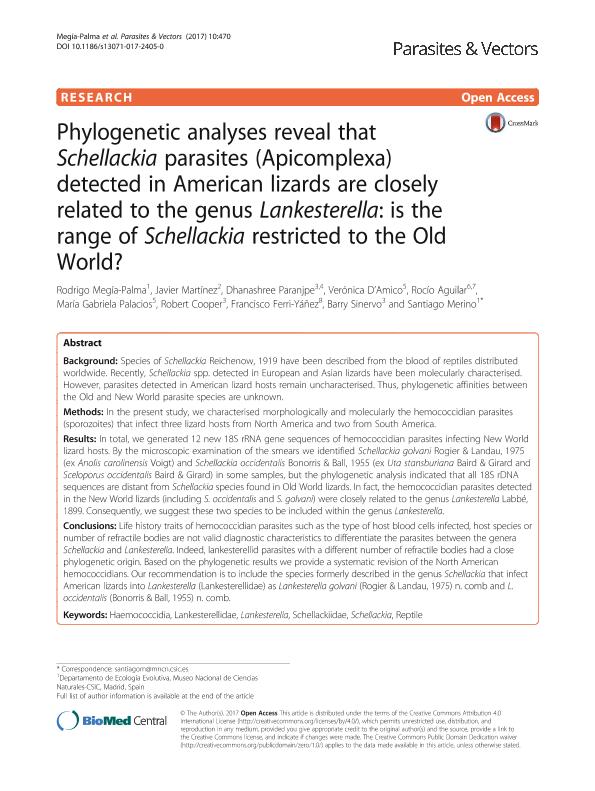Artículo
Phylogenetic analyses reveal that Schellackia parasites (Apicomplexa) detected in American lizards are closely related to the genus Lankesterella: is the range of Schellackia restricted to the Old World?
Megía Palma, Rodrigo; Martínez, Javier; Paranjpe, Dhanashree; D'amico, Veronica Laura ; Aguilar, Rocío
; Aguilar, Rocío ; Palacios, María Gabriela
; Palacios, María Gabriela ; Cooper, Robert; Ferri Yáñez, Francisco; Sinervo, Barry Raymond; Merino, Santiago
; Cooper, Robert; Ferri Yáñez, Francisco; Sinervo, Barry Raymond; Merino, Santiago
 ; Aguilar, Rocío
; Aguilar, Rocío ; Palacios, María Gabriela
; Palacios, María Gabriela ; Cooper, Robert; Ferri Yáñez, Francisco; Sinervo, Barry Raymond; Merino, Santiago
; Cooper, Robert; Ferri Yáñez, Francisco; Sinervo, Barry Raymond; Merino, Santiago
Fecha de publicación:
10/2017
Editorial:
BioMed Central
Revista:
Parasites and Vectors
ISSN:
1756-3305
Idioma:
Inglés
Tipo de recurso:
Artículo publicado
Clasificación temática:
Resumen
Background: Schellackia species have been described from the blood of reptiles distributed worldwide. Recently, Schellackia species detected in European and Asian lizards have been molecularly characterized. However, parasites detected in American host lizards remain uncharacterized. Thus, phylogenetic affinities between Old and New World parasite species are unknown.Methods: In the present study, we have morphologically and molecularly characterized hemococcidian parasites (sporozoites) that infect three lizard hosts from North America and two from South America.Results: In total, we achieved 12 new 18S rDNA gene sequences of hemococcidian parasites infecting New World lizard hosts. On the one hand, by the microscopic examination of the smears we identified Schellackia golvani (ex Anolis carolinensis) and Schellackia occidentalis (ex Uta stansburiana and Sceloporus occidentalis) in some samples, but the phylogenetic analysis indicates that all 18S rDNA sequences are distant from Schellackia species found in Old World lizards. In fact, the hemococcidian parasites detected in New World lizards (including S. occidentalis and S. golvani) were closely related to genus Lankesterella. Consequently, we suggest these two species to be included within the genus Lankesterella.Conclusions: Life history traits of hemococcidian parasites such as type of host blood cell infected, host species or number of RB were not valid diagnostic characteristics to differentiate the parasites between the genera Schellackia and Lankesterella. Indeed, lankesterellid parasites with different number of refractile bodies had close phylogenetic origin. Based on the phylogenetic results we suggest a systematic revision of the American hemococcidia. Our recommendation is to include the species formerly described in genus Schellackia (i.e., S. golvani and Schellackia occidentalis) that infect American lizard into genus Lankesterella (Lankesterellidae).
Palabras clave:
Haemococcidia
,
Lankesterellidae
,
Reptile
,
Schellackiidae
Archivos asociados
Licencia
Identificadores
Colecciones
Articulos(CESIMAR)
Articulos de CENTRO PARA EL ESTUDIO DE SISTEMAS MARINOS
Articulos de CENTRO PARA EL ESTUDIO DE SISTEMAS MARINOS
Citación
Megía Palma, Rodrigo; Martínez, Javier; Paranjpe, Dhanashree; D'amico, Veronica Laura; Aguilar, Rocío; et al.; Phylogenetic analyses reveal that Schellackia parasites (Apicomplexa) detected in American lizards are closely related to the genus Lankesterella: is the range of Schellackia restricted to the Old World?; BioMed Central; Parasites and Vectors; 10; 470; 10-2017; 1-10
Compartir
Altmétricas



